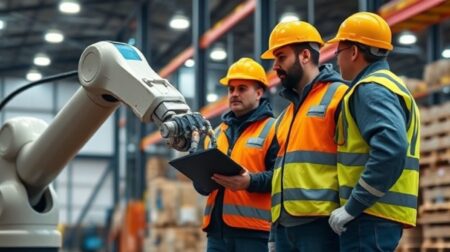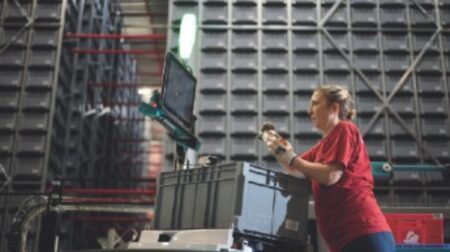Some big firms are investing in automation but smaller ones need convincing. Robotics & Innovation asks what benefits would persuade them to dive straight in?
Oana Jinga, Co-Founder, BotsAndUs
The unprecedented impact of the pandemic on supply chains – and the added labour pressures to already stretched operations – have created the perfect storm, and we are seeing the acute need for logistics and warehousing to quickly adapt to stock changes, space optimisation and workforce shortages. The challenges they face are glaringly clear – 25 billion ft2 of warehouses globally are set to increase by 50% by 2025. There is also a shortage of tens of thousands in the warehouse workforce, raising wages by up to 20%.
Billions of dollars are lost annually in the logistics industry due to the lack of real-time data on warehouse operations and crucial logistics nodes. The key in this equation is automation. Automating acceptance and stock processes immediately leads to increased productivity and efficiency. There are several examples where the adoption of automation has eased the pressure on resourcing and efficiency.
It is also easy to see how once tasks that are manual, paper-based and labour-intensive are automated (for instance measuring pallets for dimensional accuracy), it frees the workforce to focus on more complex, value-adding tasks.
A cargo warehouse today loses hundreds of thousands of pounds from assets with under-reported dimensions. Automation solves this with full, remote visibility in real-time. It leads to better inventory control, where goods with under-reported volumes can now be easily identified. It also ensures that relevant stock is always available to pickers and it cuts down on errors in logistics such as early detection of non-compliant goods. It’s the same with damaged goods for insurance claims, allowing for recovery of revenues that would otherwise be lost in the process.
We can see the benefits being realised in real-time as our autonomous mobile robots are doing exactly this right now – measuring, tracking and finding goods with zero manual intervention and zero warehouse downtime.
Alex Moore, Contracts Manager, Invar Integration
If businesses want to keep delivering year-on-year cost savings and increase operational efficiencies, they need to look toward new automated solutions that are flexible and scalable.Automation can be used to streamline processes and enable profitable growth. A combination of conventional and robotic technologies – coupled with the right software – can allow clients to vastly increase accuracy, efficiency and productivity.
Invar Group has built its reputation by offering seamless integration of solutions, solving a variety of logistic challenges. By incorporating hardware, software and technical support, we offer end-to-end care.
Faced with the challenge of future-proofing its existing fulfilment capacity, an Invar customer realised the need to implement new ways of working, and fast. We centred the project around an intelligent goods-to-person operation, utilising AMRs and pick-to-light technology. The UK operation now reports huge improvements in the replenishment process and throughput of 30,000 order lines per day, supplying product to several international hubs. One of the major advantages to this was utilising our IWS software, a customisable system, configured to suit specific operational requirements for the project. Our IWS software is a trusted and well-recognised system, it’s easily configured interface ensures new technologies can be added with minimal effort, allowing it to adapt as new technologies become available.
James Wroath, Chief Executive, Wincanton
As the economy recovers and renews, it is also changing. Once seen as a threat to employment prospects, the application of automation and robotics is now an essential tool that supports a skilled workforce.
Automation and robotics drive resilience. Technology doesn’t mind working night-shifts and it doesn’t mind working at weekends, with a skilled team of colleagues to manage and maintain its use. It complements colleagues in situations where manual solutions alone would cause bottlenecks in the flow of products around the warehouse. As a result, activity can be squeezed into shorter periods of time ensuring later cut-off times can be achieved. These economies of scale drive a much higher level of resilience.
At Wincanton’s high-volume shared user e-fulfilment centre in Nuneaton, we utilise advanced AMR technology for leading e-commerce brands to improve speed, accuracy and safety in order fulfilment.
Increasing the application of innovation to provide resilience in supply chains means utilising technology that serves a purpose for our customers. We are supporting major retailers through investments in the best technologies. This includes the introduction of ‘Master Mover’ AGVs in warehouses we manage for our customers, and ergonomic container de-stuffers that prevent strain and fatigue in manual processes.
For many UK businesses, technology is at the forefront of the customer experience. It builds relationships with consumers, speeds-up transaction times and provides greater insight into performance, enabling better decisions.
Joe Daft, Head of Robotics, Wise Robotics
Automation is going to be key to unlocking significant and long-lasting performance. Since the start of Covid-19, we’ve seen automated solutions transforming warehousing in ways that signal a new, smart, technology-driven future.Allowing businesses to process orders of all sizes, more quickly and efficiently, the deployment of these solutions will only increase over time – especially as the demand for next-day and same-day delivery continues to force the need for even better productivity and enhanced efficiency.
Currently, among SMEs, automation adoption rates in the UK stand at just 4%, compared to 28% in large businesses.
However, this looks set to change as the solutions become more accessible, more flexible and better understood, and businesses begin to realise the return-on-investment potential. We are seeing this increase through work with our customers and it’s why we continue to diversify our range, recently announcing a new partnership with VisionNav that will see us supply its range of vision-guided autonomous robotic forklifts alongside our AMRs and CTUs (container transport units).
One of the biggest factors we’re seeing in driving the adoption of these solutions is the need for business transformation to address the shortage of industrial and logistics space. In fact, a recent report found that requirement increased by 44% in 2021, exceeding 50 million ft2for the second year in a row.
With land in short supply and ongoing labour pressures squeezing businesses, automation provides options that are going to become much more valuable to manufacturers, retailers, logistics firms and other organisations that are operating warehouses. It has been suggested that automated warehousing robotics could save up to 85% of otherwise wasted warehouse space and reduce 60% of labour costs – all the while increasing throughput and accuracy. It’ll be a big shift for many organisations, and automation will need to be considered from the ground up. But the potential gains are staggering.
Sandeep Sakharkar, Chief Information Officer, GXO Logistics
The transition to automation is already well underway and it’s transforming our industry and the way we work, making logistics safer, swifter and more sustainable. Among the biggest beneficiaries of this transition are our team members. For example, we’ve found that advanced automation – such as the use of robots to perform repeatable movements over sustained periods – not only improves speed and accuracy in our warehouses, but also increases the safety of our employees, protecting them from such health issues as repetitive strain. In other words, by using robotics in logistics, we can make human work safer and more secure, while also providing up to a sixfold increase in productivity.
The use of technology and advanced automation is having a profound impact on the logistics industry. Fast-evolving AI and machine learning – coupled with rapid progress in robotics automation seamlessly integrated with differentiated software solutions – have created amazing possibilities in warehouse design. Sophisticated robotics, along with automated sorting or picking systems and intelligent analytics, enable us to create smarter, more agile supply chains. I find the increasing repertoire of robotic capabilities really exciting for our industry, and those capabilities and the value they can deliver are improving all the time. Around the world, we are implementing innovative technologies like geopositioning and precise geolocation, machine vision, a variety of sensors, speech recognition and more in our intelligent warehouse designs. These allow us to deliver high levels of throughput that can only be achieved through the use of automation working alongside our team members.
None of this is a flight of fancy. We’ve already created and delivered advanced automation- and technology-driven supply chain solutions. Our flagship digital warehouse and technology incubator for Nestlé in the UK is a great example. It brings the latest technologies together under one roof to create a logistics command centre driven by innovation. The nearly 640,000ft2 distribution centre’s digital ecosystem integrates predictive data capabilities, intelligent machines and state-of-the-art automation, co-developed with Swisslog Logistics. The site features smart robots that are capable of taking full pallets of product from storage and building mixed product pallets of various sizes. It has an automated infeed and outfeed averaging throughput of more than 60,000 cases a week and 750m of monorail tracks to move pallets around the warehouse.
In fact, the Nestlé facility is more than a warehouse – it’s also a laboratory to test and trial new technologies and operational procedures. We like to think of it as both a think tank and a launch pad for Nestlé and GXO innovations, and it is already having a far-reaching impact on the way we and our customers do business. We see this as the shape of things to come. The supply chain industry is wide open for disruptive thinking. At GXO, we’re driving positive change, using new logistics technologies to transform our industry, and the biggest benefits are safer, swifter and more sustainable logistics for our customers and our employees.








